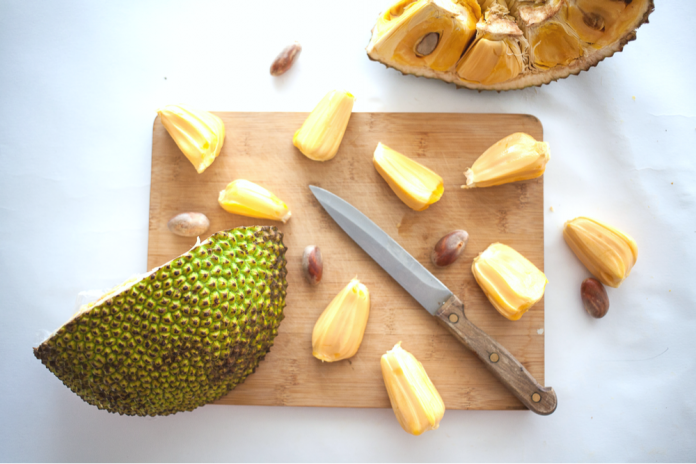It is easy to get into the routine of getting the same fruits, vegetables, and grains every week. However, when looking past the common and familiar fruits, vegetables, and other plant foods, you will notice some unfamiliar or strange-looking foods.
Bypassing these unusual foods for more familiar ones may be tempting. But there are benefits to adding these unique items to any grocery list, including those following a vegetarian diet or simply trying to eat more plant-based.
Ready to break the barrier of trying new and unfamiliar plant foods? Read on for how and why these unique plant-based foods can easily be added to a plant-based diet menu.
15 Foods that Need to be Added to a Plant-Based Food List
These more exotic-sounding or unfamiliar-looking plant-based foods need not be avoided. They are full of healthy nutrients and can easily be a delicious and different addition to any plant-based diet.
Jackfruit
Jackfruit is gaining in popularity worldwide and can now be found at many larger grocery stores. Jackfruit is native to South Asia, and, until recently, was so prevalent thousands of pounds of this fruit went to waste every year.
Jackfruit is hard to miss – it is very large compared to other fruits sporting a spiky, green exterior. The inside flesh can be described as “meaty” and because of this, it is often used as a vegan meat alternative in many whole food, plant-based recipes. For example, jackfruit can be used in curries, tacos, or as an alternative for pulled pork.
As jackfruit grows in demand, products are popping up in more ways. Jackfruit can also be found as frozen or canned items.
Banana Blossom
Banana blossoms have a purple outside layer and grow at the end of a banana bunch. Similar to jackfruit, the banana blossom is native to Southeast Asia and growing in popularity plant-based meat alternative.
While jackfruit is commonly used as a beef, pork, or chicken substitute, banana blossom can be more commonly used as a seafood alternative. The “meat” of the banana blossom can flake when cooked, similar to fish. Nutritionally, banana blossoms are a good source of fiber, vitamins, and minerals.
Banana blossoms can simply be added to dishes by finely dicing up and tossed into green or fruit salads, stir-fries, or other cooked dishes. While fresh banana blossoms are not easy to find outside of Southeast Asia, some supermarkets are selling banana blossoms preserved in brine or canned, which is a commonly used way of buying and cooking.
Breadfruit
Breadfruit, in the same family as jackfruit, originates in the South Pacific. According to Britannica, breadfruit is not eaten raw, as it is quite starchy.
Like a potato, it can be roasted, baked, boiled, fried, or dried and ground into flour. Products with breadfruit flour are available as well as snacks such as chips.
Plantains
While most people may be familiar with what a plantain is and how it looks, it can still be unfamiliar to cook with. Similar in appearance to a banana, plantains differ in that they need to be cooked instead of eaten raw.
Why add plantains to a plant-based diet menu? Plantains are not only delicious but good for digestive and heart health. Plantains are a good source of prebiotic fiber, potassium, magnesium, and vitamin C.
While plantains can be fried, the healthiest cooking methods for plantains, similar to potatoes, are boiling or roasting them. They can often be used as a substitute for potatoes in most recipes for side dishes, soups, or fried in an air fryer for a lower calorie cooking option. Yellow to brown plantains can be used similarly to overripe bananas for baking recipes.
Jicama
The humble-looking jicama is a brownish, round root vegetable. It has just a hint of sweetness and crunchy texture making it appealing for almost everyone.
Jicama is easy to use in many dishes and just needs to be peeled and then enjoyed raw. It can be cut up and served with dips or enjoyed in salads.
Kohlrabi
Kohlrabi can be found in season during the fall in many farmer’s markets around the country. The veggie can look a little daunting with thin stems and leaves shooting off a larger, green root bulb. While the stems and leaves can be sauteed with olive oil and eaten, the bulb part should have the outer layer peeled away.
Like other root vegetables, once peeled, the root can be roasted with olive oil and favorite seasonings. The bulb can also be eaten raw and added to salads or slaw dishes for a crunchy, slightly sweet addition.
Buddha’s Hand
It’s not hard to know where Buddha’s hand got its name, as this unique fruit literally looks like a hand with finger-like projections. Buddha’s hand has a citrus-like flavor. Unlike other citrus fruits, the outer layer is not bitter but sweet.
The finger-like projections can be shaved, grated, or zested onto salads, yogurt, oatmeal, or smoothies for a sweet citrus flavor. Additionally, it can add a boost of antioxidants and vitamins to any fruit recipe.
Baobab Fruit
Baobab is a large, brown, oval fruit native to Africa. Almost every part of the baobab tree can be used nutritionally or medicinally in some way, including the roots, bark, leaves, seeds, flowers, and the baobab fruit. In fact, it is estimated there are 300 ways local communities use the different parts of the baobab tree!
While fresh baobab is hard to find, baobab powder is easy to find online or in most health stores. Baobab powder is made from drying baobab fruit and grinding it to a powder form. Baobab powder can be added to drinks, yogurt, or oatmeal for a boost of antioxidants, fiber, and minerals.
Fiddleheads
Fiddlehead ferns are unique in that they are a green vegetable that is all curled up. They are common in both French and Asian cooking but are still unfamiliar to other regions of the world. They are usually most widely available in the spring and have a grassy-like flavor similar to asparagus.
Fiddleheads are a great source of minerals, omega 3’s, and antioxidants. Fiddleheads should not be eaten raw but can easily be roasted, steamed, sauteed with garlic and lemon, or dressed with a vinaigrette.
Kumquat
The kumquat fruit is a unique, small, citrus-flavored fruit that has both sweet notes from the edible peel and sour notes from the inside. They are delicious as a raw snack, but kumquats can also be added to a plant-based diet menu by adding them to sauces and marinades or using in desserts and jams/jellies.
Kumquats are considered in season during winter months but may be available other times of the year in some specialty or large grocery stores.
Freekeh
Instead of using the standard rice, couscous, quinoa, or bulgur, as a grain turn to the whole grain freekeh. If you have not heard of freekeh, it is traditionally used in Middle Eastern and Mediterranean cuisines. Freekeh can be used “whole” or cracked, similar to bulgur, in which cracked freekeh will have a shorter cooking time.
Freekeh is harvested when the grain is still green. Then it gets roasted which gives it a unique, smoky flavor.
Besides the unique taste, freekeh is considered a grain high in fiber and low in the glycemic index. It is also a good source of plant-based protein, which is important if reducing animal products or following a strict vegan diet. Freekeh can be used in dishes that use other whole grains.
Kamut
While not totally gluten-free, Kamut is considered a grain that is lower in gluten than other grains. As such, it may be more tolerable for people with mild gluten intolerances. Besides being lower in gluten, another reason to add Kamut to a plant-based food list is that it is also a good source of iron and fiber.
Kamut is a larger grain size that is more similar to farro or wheat berries. Because of this, Kamut can pair well in stews or salads.
Teff
Another unique whole grain to try that is native to Ethiopia is teff. Fun fact: teff is considered the smallest grain in the world.
While small in size, it has some big nutritional benefits being high in iron, fiber, protein, calcium, magnesium, and manganese. It is also a gluten-free grain.
Teff is growing in popularity and may soon be at the same popularity level as quinoa. Teff flour is another use with big nutritional benefits and can be used for breads, polenta-like dishes, baked goods, or pancakes.
Tiger Nut Flour
Tiger nut is actually a root vegetable that also goes by the names nut grass, yellow nutsedge, tiger nutsedge, edible galingale, water grass, and earth almond. Since it is not an actual nut, it can be enjoyed by those who have nut allergies. In fact, tiger nut flour is popular not only for plant-based diets but also in low-carb, gluten-free, and paleo diets.
Tiger nut flour is made by roasting the root vegetable and grinding it to a powder. The flour can be used in the same way as other gluten-free flours like almond or coconut flour for desserts or baked goods.
Ground Cherries
Ground cherries (also called husk cherries or winter cherries) may not be found at grocery stores, but they can be found at local farmer’s markets or in a local garden. When ripe, they fall to the ground, hence their name.
Ground cherries have a sweet flavor and a texture like a cherry tomato. Similar to tomatillos, a paper-like outer hull just needs to be pulled away, then the whole fruit can be eaten.
They are delicious as a sweet, stand-alone snack or atop ice cream. Smithsonian Magazine also suggests they can be made into a jam, added to salads, or specifically paired with cherry tomatoes and basil.
In Summary: Unique Plant-Based Foods
While it is tempting to go into auto-pilot mode and choose the same plant-based foods at the store or market, these 15 unique plant foods deserve to be added to the list. These unique foods may look or sound intimidating, but they can easily be incorporated into salads, stews, stir-fries, or stand-alone snacks.
Besides adding a different flavor, these plant-based foods will also add a boost of beneficial nutrients to the diet!
References:
Bain Z. Uncommon fruits and veggies. Delish. Published September 16, 2020. https://www.delish.com/food/g603/exotic-fruits-vegetables/?slide=1.
Brennan D. Plantain: Health benefits, nutrients per serving, preparation information, and more. WebMD. Published September 17, 2020. https://www.webmd.com/diet/health-benefits-plantains#1.
Covington L. What is tiger nut flour? The Spruce Eats. Published July 22, 2021. https://www.thespruceeats.com/what-is-tigernut-flour-4771200.
Getz L. The Richness of Teff. Today’s Dietitian. https://www.todaysdietitian.com/enewsletter/enews_0915_01.shtml.
Jackfruit goes global: How India’s SUPERFOOD is becoming the world’s preferred meat alternative. The Economic Times. https://economictimes.indiatimes.com/magazines/panache/jackfruit-goes-global-indias-superfood-is-becoming-the-worlds-preferred-meat-alternative/articleshow/75798621.cms?from=mdr.
Moncada K. Banana blossoms: The trendy plant-based seafood substitute that literally grows on trees. Better Homes & Gardens. Published June 1, 2021. https://www.bhg.com/recipes/how-to/cook-with-fruits-and-vegetables/banana-blossoms/.
Putnam H. 10 good-for-you Ancient grains to cook with now. Foodiecrush. Published October 4, 2017. https://www.foodiecrush.com/10-grains-you-should-be-cooking-with-right-now/.
Sterling J. Everything you need to know About Fiddlehead ferns. Food & Wine. Published May 23, 2017. https://www.foodandwine.com/vegetables/everything-you-need-know-about-fiddlehead-ferns.







